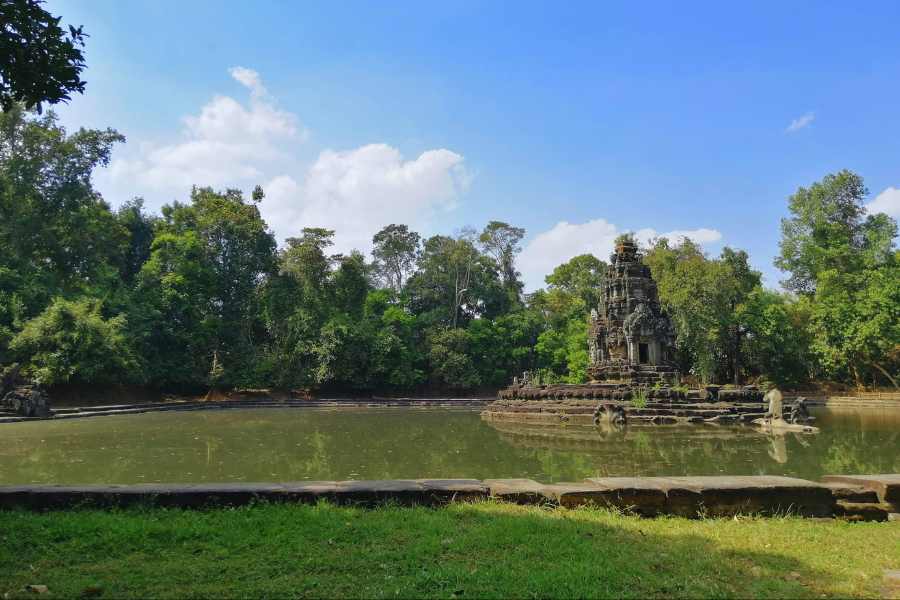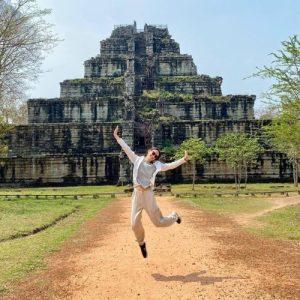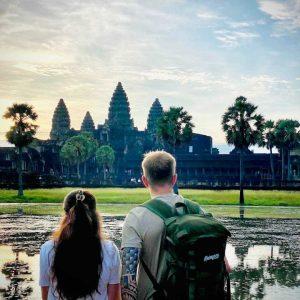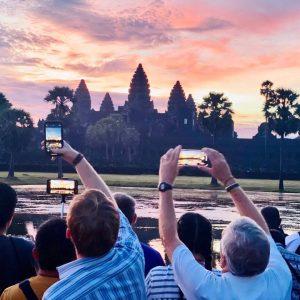Neak Pean Temple – Uncover Mysterious History and Healing Symbolism
July 31, 2023

Table of Contents
Neak Pean Temple – Uncover Mysterious History and Healing Symbolism
An In-Depth Guide to the Magnificent Neak Pean Temple
Located near the ancient Khmer city of Angkor, Cambodia, the Neak Pean temple is a unique and fascinating Hindu-Buddhist temple that embodies both beauty and spirituality. Built in the 12th century, Neak Pean (“entwined serpents” in Khmer) features a rich history and captivating architectural design that makes it a must-see for any visitor to the Angkor Archaeological Park.
Key Takeaways:
- Built in the late 12th century as a healing temple with sacred waters
- Dedicated to Buddha and the bodhisattva Avalokiteshvara
- Architectural mandala design with five interconnected pools
- Statues and carvings reflect Mahayana Buddhist symbolism
- Part of the sprawling Angkor complex from the Khmer empire era
- Harmoniously blends nature and architecture
- understanding its history and symbolism unlocks deeper meaning
An Oasis of Calm in the Cambodian Jungle
Set on an artificial island surrounded by five serene pools, Neak Pean radiates a sense of peace and tranquility. As you approach along the wooden walkway that crosses the largest pool, take in the temple’s harmonious blend of water, gardens, and sandstone structures. Dubbed the “Hospital Temple,” Neak Pean was originally designed as a healing sanctuary, with its healing waters symbolically cleansing those who bathed in them.
Once inside the main temple area, marvel at the two giant stone Nagas whose intertwined tails give Neak Pean its name. Their curved bodies encircle the central shrine, guarding its eastern entrance. Together with the tranquil pools, they create an oasis of calm in the Cambodian jungle.
The Significance and Symbolism of Neak Pean’s Architecture
Like most Khmer temples, Neak Pean is highly symbolic in its layout and design. The central pool represents Lake Anavatapta in the Himalayas, which is believed to be the source of the four great rivers of India. Around it are four smaller pools symbolizing water, fire, earth and air.
Connecting each pool is an animal-shaped waterspout, representing the elements associated with healing:
- Lion (Fire)
- Horse (Air)
- Elephant (Water)
- Human face (Earth)
Pilgrims would bathe in the central pool, then visit the smaller pool corresponding to their astrological sign or illness, to receive the healing properties of that element.
The central shrine sits on a base carved like a lotus, enhancing the symbolism of Neak Pean as an earthly paradise. Its cruciform layout represents the four directions and555 elements. The eastern pediment depicts the Great Departure of Buddha, beginning his path to enlightenment.
The Intriguing History Behind Neak Pean’s Construction
Built in the late 12th century, Neak Pean was commissioned by King Jayavarman VII, who constructed many temples and infrastructure projects around Angkor. Its original name was Rajyasri, meaning “the king’s glory.”
Some historians believe it was built on the site of a former royal palace or temple, due to the Hindu iconography found there. The Linga (symbol of Shiva) and Yoni (female counterpart to the Linga) sculptures point to possible Hindu origins.
The temple was later dedicated to Avalokiteshvara, the bodhisattva of compassion, and Buddha, reflecting the Mahayana Buddhism practiced at the time. As Buddhism rose in prominence, earlier Hindu imagery was incorporated into Buddhist iconography.
Must-See Highlights of Neak Pean
A visit to Neak Pean should include:
- The statue of Balaha, the mythical flying horse. Balaha is depicted rescuing drowning sailors, a reference to one of Buddha’s previous lives.
- The east-facing seated Buddha in the central shrine, in a meditative pose.
- The guardian Nagas encircling the shrine. Their intertwined tails resemble three heads from certain angles.
- The eastern pediment showing the Great Departure in superb detail.
- The four chapels on the cardinal points, with waterspouts shaped as a lion, horse, elephant and human face.
Tips for Visiting Neak Pean Temple
- Visit in the wet season (May to October) when the pools are full. The dry months offer a better view of the statue of Balaha.
- Join a guided tour to fully appreciate the history and symbolism. The guides from Siem Reap Shuttle offer excellent private tours.
- Arrive early morning or late afternoon for the best light. Midday sun creates harsh shadows.
- Dress appropriately by covering legs and shoulders.
- Bring mosquito repellent. The pools can breed mosquitoes.
An Enduring Sanctuary of Healing and Meditation
Despite looting and decay over the centuries, Neak Pean’s calming atmosphereremains intact. While its healing waters may have dried up, their symbolic power lives on. Just sitting and meditating in this temple transports you to a world of spiritual peace and harmony with nature.
As one of the 70+ temple sites around Angkor, Neak Pean rewards visitors with its serene beauty and religious meaning. Understanding its history and symbolism lets you appreciate it on a deeper level. A trip to Siem Reap is incomplete without spending time at this unique oasis, where Cambodian engineering and faith gloriously combine.
Neak Pean Temple is truly a one-of-a-kind temple that exemplifies the Khmer empire’s architectural genius and spiritual beliefs. Built as a healing sanctuary, its pools and shrines provide a tranquil setting for meditation and reflection. A visit here provides a break from the crowds and a chance to ponder the ingenuity of Angkor’s planners. Whether you’re exploring Angkor independently or booking a private tour, Neak Pean deserves a place on your itinerary.
Unlocking the Secrets of Neak Pean Temple
What is the history of Neak Pean Temple?
Nestled amidst Cambodia’s ancient Angkor temples, the enigmatic Neak Pean has a fascinating history. Built in the late 12th century during the reign of King Jayavarman VII, this unique temple served as a medicinal sanctuary where pilgrims bathed in its healing waters.
Originally named Rajyasri (“king’s glory”), it was later rededicated to the Buddhist bodhisattva Avalokiteshvara as the empire shifted to Mahayana Buddhism. Legends speak of its restorative powers curing the sick who journeyed to this remote oasis.
While dedicated to Buddhism, Neak Pean contains Hindu iconography like the Linga and Yoni, pointing to possible Hindu origins before its conversion. Understanding Neak Pean’s rich history unlocks deeper meaning in this tranquil haven.
What is the architectural significance of Neak Pean Temple?
Neak Pean stands out for its harmonious blend of architecture and nature. It occupies a 350 x 350 meter island with five interconnected pools representing the elements – earth, fire, water and air.
At the center lies the main shrine on a lotus-shaped base. Its cruciform layout symbolizes the four directions. Sandstone Nagas encircle the pedestal, guarding the shrine. Four smaller pools corresponding to the elements radiate from the main pool. Elaborate waterspouts connect them in the shape of a lion, horse, elephant and human face.
This interplay between the pools and ornate central sanctuary creates a perfectly balanced mandala, integrating temple and nature. Neak Pean is architecturally significant as a uniquely Khmer vision of paradise.
How is Neak Pean Temple related to the Angkor temples?
As part of the sprawling Angkor complex from the Khmer empire’s golden age, Neak Pean shares stylistic elements with Angkor’s other 12th century temples.
Built during the prolific reign of Jayavarman VII, Neak Pean’s cruciform layout and statue of Buddha echo design motifs seen at temples like Ta Prohm and Bayon. Its bas-reliefs depicting scenes from Buddhist mythology also resemble those found throughout Angkor.
Yet Neak Pean stands apart in its symbolic integration of water and architecture. While Angkor Wat highlights Hindu mythology in its stone carvings, Neak Pean’s tranquil setting expresses a distinctly Buddhist vision of spiritual harmony with nature – revealing the empire’s shift to Mahayana Buddhism.
Who was Jayavarman VII and what is his connection to Neak Pean Temple?
King Jayavarman VII presided over the Khmer empire’s golden age in the late 12th/early 13th century. He spearheaded a massive building campaign across Angkor, constructing temples, roads and infrastructure.
As a devout Mahayana Buddhist, Jayavarman VII dedicated many state temples to Buddha, like the famous Bayon. Neak Pean was one of his grand building projects, designed as a peaceful haven for healing and worship. Its Buddhist dedications like the statue of Buddha and dharma scenes reflect Jayavarman VII’s religious legacy.
Understanding the prolific builder-king who created Neak Pean provides insight into this temple’s Mahayana Buddhist character and place in Angkor’s evolution.
How does Khmer architecture reflect in Neak Pean Temple?
Neak Pean contains quintessential aspects of Khmer temple architecture, like:
- Cruciform layout with a central spire
- Lotus-shaped pedestals with Naga balustrades
- Sandstone bas-reliefs depicting Buddhist/Hindu myths
- Statues of deities like Buddha and Vishnu
- Integration with nature through water features
Yet Neak Pean also innovates through its mandala design of concentric pools. Khmer architects mastered hydraulic engineering to incorporate water symbology at a scale unmatched elsewhere in Angkor.
The harmonious balance between water and architecture at Neak Pean highlights the Khmer genius for temple composition using sightlines, axes and natural elements.
What are the Buddhist influences in Neak Pean Temple?
As a state temple from the Mahayana Buddhist era under Jayavarman VII, Neak Pean contains prominent Buddhist imagery and teachings.
The statue of Buddha, pediments showing his life, and dharma carvings signify Buddhist dedications. The central spire’s cruciform shape represents the four directions and elements, cosmos symbolism important to Buddhism.
The temple’s medicinal function also echoes Buddhist views of water’s purifying nature and the pursuit of health as part of the Eightfold Path. By Jayavarman VII’s time, earlier Hindu themes were adapted to fit Buddhist perspectives. Neak Pean stands testament to this shift in official religious focus.
What are the main attractions of Angkor Archaeological Park, including Neak Pean Temple?
The Angkor complex contains scores of breathtaking temples from the Khmer empire’s zenith. Main highlights include:
- Angkor Wat – Massive 12th century temple with exquisite bas-reliefs
- Bayon – Buddha faces carved into soaring towers
- Ta Prohm – Jungle-entwined temple made famous by Tomb Raider
- Neak Pean – Serene island temple with healing pools
- Banteay Srei – Intricately carved pink sandstone temple
- Angkor Thom – Walled city with sites like Bayon and Terrace of the Elephants
A multi-day pass allows you to experience Angkor’s diversity at your own pace. Neak Pean offers a peaceful contrast to the grand temples.
What is the significance of the Baray and water temples in relation to Neak Pean Temple?
Neak Pean sits on an artificial island in Jayatataka, the last major Baray (reservoir) built in Angkor. The Khmers engineered these massive reservoirs for irrigation and symbolic purposes.
Neak Pean was a “water temple” designed around spiritual symbolism of water. Its pools represent the mythical Himalayan lake Anavatapta, venerated for its healing properties.
The Baray and sites like Neak Pean demonstrate the Khmer mastery of hydro-engineering and water’s sacred significance in their belief system. Just west, the earlier West Baray contains another water temple, the cruciform Mebon. But Neak Pean’s ambitious mandala design takes water temple architecture to new heights.
How is Neak Pean Temple connected to the Preah Khan complex?
Preah Khan (“sacred sword”) is a huge temple and monastic complex just northwest of Neak Pean, also built under Jayavarman VII in the late 12th century.
Both were located in the Angkor capital region anchored by the walled city of Angkor Thom. Each has design elements typical of Jayavarman VII’s Mahayana Buddhist period, including statues of Buddha and related iconography.
In some ways Neak Pean is a miniature, more mystical counterpoint to Preah Khan’s grand processional walkways and laboratories. But Neak Pean’s astrological symbolism and healing functions complement the larger complex. Together, they provided physical and spiritual sustenance for the capital’s inhabitants.
How does Neak Pean Temple compare to Angkor Wat?
Angkor Wat, built in the early 12th century, is the largest and most iconic Khmer temple. It reflects the imperial patronage of Hinduism.
In contrast, Neak Pean was built just decades later by a devout Buddhist king. The two differ markedly in:
- Scale – Angkor Wat is vastly larger
- Layout – One is structured around Hindu mythology, the other around a Buddhist mandala
- Focus – Angkor Wat highlights Vishnu, Neak Pean depicts Buddha’s life
- Bas-reliefs – Angkor Wat has epic Hindu battle scenes, Neak Pean features dharma and nature motifs
- Integration with nature – Neak Pean seamlessly blends water and architecture
While both express Khmer genius, Neak Pean reveals an empire transformed religiously, politically and artistically from Angkor Wat’s era – providing a more tranquil, introspective counterpoint.
With its complex history and rich symbolism, Neak Pean offers much more than meets the eye. Peeling back its layers provides insight into Angkor’s evolution from Hindu to Buddhist influences. A visit here truly completes any journey through Cambodia’s ancient temples.
Mattia
Recent Post
Get 30% Discount Now
Categories
Guided Tours

Private Siem Reap Airport SAI Transfers – Siem Reap Airport Pick-up or Drop-off, Just for You!
From: 30$
Shared SAI Siem Reap Airport Transfer – We depart every 1 hour!
From: 9$
Private Full-Day Siem Reap to Koh Ker & Beng Mealea Temple Tour
From: 75$
2-Day Angkor Wat Sunrise & Banteay Srei Grand Tour – Small Group Tours
From: 30$
2-Day Angkor Wat Temple Sunset and Floating Village Tour
From: 40$
3-Day Angkor Wat Sunrise, Banteay Srei and Floating Villages Tour – Small Group Tours
From: 50$